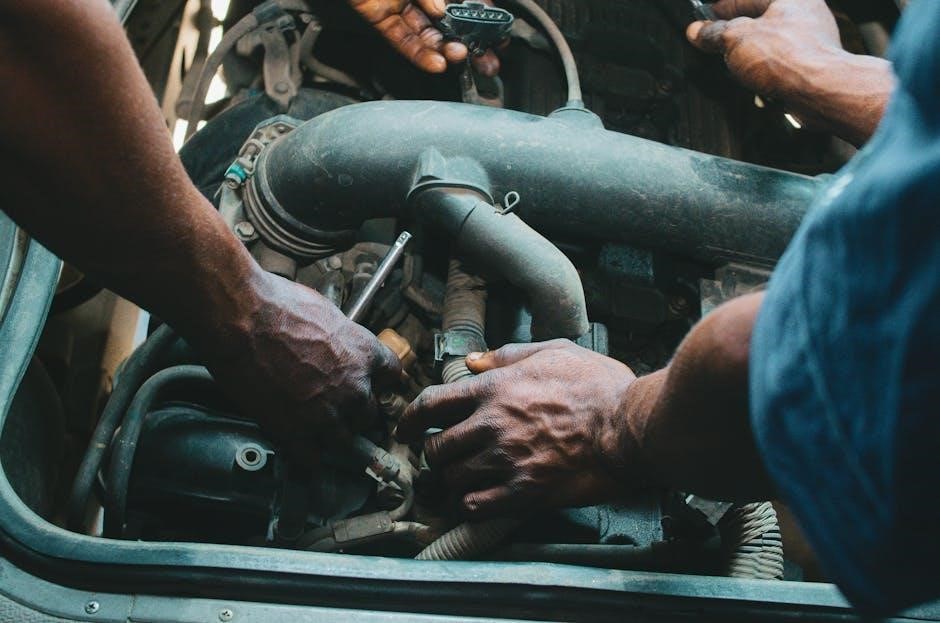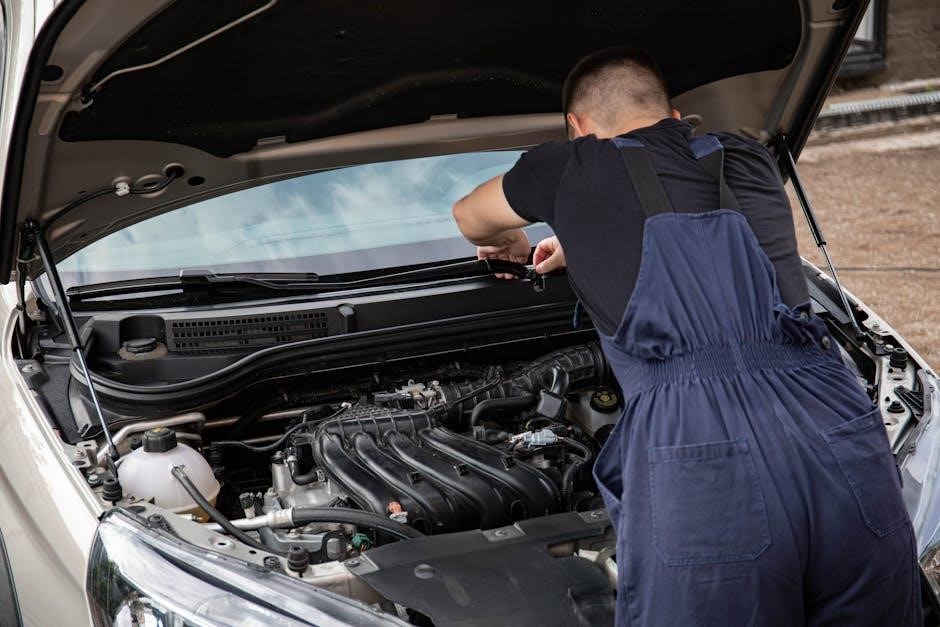Welcome to the Wii manual troubleshooting guide. This section provides essential steps to resolve common issues using the official Wii operations manual. Learn to identify and fix problems efficiently, ensuring optimal performance. Troubleshooting tips cover disc errors, connectivity, and error codes, helping you restore your Wii to full functionality.
Use this guide to navigate through diagnostics and solutions with ease.
Common Wii Issues and Solutions
The Wii often faces issues like disc read errors, connectivity problems, and error codes. This section provides straightforward solutions from the manual to resolve these common problems quickly.
Learn how to troubleshoot and maintain your Wii for optimal performance.
Disc Read Errors
Disc read errors are common issues with the Wii console. They often occur due to dirty or scratched discs, incorrect disc format, or laser lens wear.
First, ensure the disc is clean and free of scratches. Use a soft cloth to wipe gently. If the issue persists, reset the console by unplugging the AC adapter for 30 seconds.
Check that the disc is compatible with the Wii. For persistent problems, consult the Wii manual or contact Nintendo support for further assistance. Regular maintenance can prevent such errors.
Connectivity Problems
Connectivity issues with the Wii often relate to internet or wireless connections. Ensure your router is functioning properly and restart it if necessary.
Check the Wii’s internet settings in the System Settings menu and verify the connection to your network. Physical obstructions or distance from the router can weaken the signal.
For wired connections, use the Wii LAN Adapter and ensure it is securely connected. If issues persist, consult the Wii manual for detailed troubleshooting steps. Resetting the Wii’s network settings or updating system software may also resolve connectivity problems. Contact Nintendo support for further assistance if the issue remains unresolved.

Troubleshooting Error Messages
Learn to identify and resolve error messages on your Wii console. This section guides you through understanding error codes and implementing solutions. Troubleshooting made easy!
Understanding Error Codes
When encountering issues with your Wii console, error codes provide crucial insights. Codes like the ” Unable to Read Disc” error often indicate hardware or software problems. The Wii operations manual details these codes, helping users identify root causes. Common errors include connectivity issues, system updates, or corrupted data. Understanding these codes is the first step toward effective troubleshooting. Referencing the manual ensures accurate diagnoses and appropriate solutions. By decoding these messages, users can address problems efficiently, restoring their Wii to optimal performance. This section simplifies the process, making error resolution accessible to all users.
Specific Error Solutions
Specific Wii error codes can be resolved with targeted solutions. For example, the “Disc Read Error” (error code -5) often occurs due to dirty or scratched discs. Cleaning the disc or resetting the Wii can resolve this. Connectivity issues, like error code 51330, may require updating the console’s system software or resetting the AC adapter. Error code 32002, related to Wii Shop Channel access, can be fixed by checking internet settings and ensuring a stable connection. Always refer to the Wii operations manual for detailed step-by-step solutions tailored to each error code. These solutions help restore functionality and ensure smooth gaming experiences. Consult the manual for precise guidance.
Model-Specific Troubleshooting
Different Wii models, such as the original Wii, Wii U, and Wii Mini, have unique troubleshooting needs. The Wii U may face connectivity issues, while the original Wii often encounters disc read errors. Refer to the specific manual for your model to address these problems effectively and maintain optimal performance.
Model-specific guides ensure tailored solutions for each console variation.
Wii vs Wii U vs Wii Mini
The Wii, Wii U, and Wii Mini each have distinct features requiring tailored troubleshooting approaches. The original Wii often experiences disc read errors, while the Wii U may face connectivity issues due to its more complex architecture. The Wii Mini, being a compact version, is prone to sensor bar problems. Understanding these differences is key to effective troubleshooting.
Consult the respective manuals for each model to address hardware-specific issues, ensuring optimal functionality. This section helps you identify and resolve problems unique to your console, enhancing your gaming experience.

Resetting Your Wii Console
Resetting your Wii console can often resolve software-related issues. To perform a soft reset, press and hold the power button on the remote or console for 5 seconds. For a hard reset, unplug the power cord, wait 30 seconds, then reconnect and restart.
These steps can fix freezes, connectivity problems, or error messages without affecting saved data. Always try resetting before attempting more complex troubleshooting. Refer to the Wii manual for detailed instructions to ensure a safe reset process and maintain your console’s functionality. Resetting is a simple yet effective first step in resolving many common issues.

Updating Wii System Software
Updating your Wii system software is crucial for maintaining performance and accessing new features. To update, ensure your Wii is connected to the internet. Navigate to the Wii Shop Channel, select “Wii System Update,” and follow the on-screen instructions.
Updates often improve stability, enhance security, and add functionality. Regularly checking for updates ensures you have the latest version. Refer to the Wii manual for detailed steps on how to perform a system update safely. Always avoid turning off the console during an update to prevent potential issues. Keeping your Wii updated guarantees a smoother gaming experience and access to the latest features.
Updates are essential for optimal performance and compatibility with games and apps.

Maintenance and Prevention Tips
Regular maintenance is key to extending the life of your Wii console. Clean the lens of your Wii discs with a soft cloth to prevent read errors. Avoid exposure to extreme temperatures or humidity. Use a high-quality power source to prevent electrical issues. Keep the console well-ventilated to avoid overheating.
Organize cables neatly to reduce tangling and damage. Update your system software regularly for the latest features and security patches. Handle the Wii Remote and accessories with care to avoid damage. Store unused components in protective cases.
By following these tips, you can ensure your Wii operates smoothly and remains in excellent condition for years.

Wii Accessories Troubleshooting
Troubleshoot Wii accessories like the Remote, Sensor Bar, and Nunchuk. Sync issues? Reset the Remote. Sensor Bar problems? Ensure proper alignment and no obstructions.
Clean contacts and restart the console for optimal performance. Replacement may be needed if issues persist. Visit Nintendo Support for detailed guides and solutions. Ensure your accessories are functioning correctly for an uninterrupted gaming experience.
Use this section to diagnose and resolve common accessory-related issues effectively. Keep your Wii accessories in top shape for smooth gameplay.
Wii Remote Issues
Experiencing Wii Remote problems? Common issues include syncing difficulties, battery drain, and sensor inaccuracies. Syncing: Press the sync button on the Remote and Wii. Battery life: Use fresh batteries or recharge. Sensor alignment: Ensure the Sensor Bar is properly placed. Interference: Move devices causing wireless interference. Physical damage: Inspect for wear or dirt; clean contacts. Reset: Press the reset button on the Remote. Replacement: If issues persist, consider getting a new Remote. Visit Nintendo Support for detailed troubleshooting guides. Resolve Remote issues to enjoy seamless Wii gameplay.
Keep your Wii Remote in optimal condition for the best gaming experience.
Sensor Bar Problems
Is your Wii Sensor Bar malfunctioning? Common issues include misplacement, dirt, or damage. Placement: Ensure the Sensor Bar is centered above or below your TV. Cleanliness: Regularly wipe the Sensor Bar with a soft cloth to remove dust. Damage: Check for physical damage; replace if necessary. Sync issues: Ensure proper alignment with the Wii Remote. Interference: Move reflective objects away. Connection: Verify the Sensor Bar is securely connected. Power: Ensure it’s powered on if using an external source. Troubleshooting: Refer to the Wii manual for advanced diagnostics.
Resolve Sensor Bar problems to maintain accurate Wii Remote tracking and gameplay.
Using the Wii Operations Manual
The Wii Operations Manual is a comprehensive guide to troubleshooting and maintaining your console. Available online, it covers setup, channels, and system settings. Key sections include error code explanations and step-by-step solutions. Health and safety precautions are emphasized to ensure proper use. Download the PDF version from Nintendo’s official website. Hard copies can be requested from Nintendo Support. Navigation is straightforward, with clear instructions for resolving common issues.
Referencing the manual ensures you address problems effectively and safely, keeping your Wii in optimal condition. Regularly consulting it helps prevent future issues and enhances your gaming experience.
Advanced Repair and Diagnosis
For complex Wii issues, advanced repair involves DIY fixes like replacing faulty components or consulting professional technicians. Bluetooth board issues often require soldering expertise. Nintendo Support offers repair options, while community forums provide detailed guides. Ensure proper tools and precautions are used to avoid further damage.
Refer to official resources for accurate repair instructions and troubleshooting.
DIY Repair Options
For technically inclined users, DIY repair options can resolve hardware issues cost-effectively. Common fixes include replacing faulty Bluetooth boards or reflowing solder on the Wii’s motherboard. Online guides provide step-by-step instructions for repairing disc drive malfunctions or addressing Wi-Fi module failures. Ensure proper tools, like soldering irons, are used to avoid further damage. Caution is essential when handling internal components. While DIY repairs can save money, they may void your warranty or cause irreversible damage if done incorrectly. Always follow trusted sources and safety protocols to minimize risks. Professional assistance is recommended for complex or sensitive repairs.
Nintendo Support and Repair
For issues beyond DIY solutions, Nintendo offers comprehensive support and repair services. Visit their official website for troubleshooting guides, repair options, and downloadable manuals. Nintendo Support provides detailed assistance for hardware and software problems. Users can contact customer service via phone or online chat for personalized help. If your Wii is under warranty, repairs may be free. Out-of-warranty repairs are available at a fee, with options for mail-in service. Nintendo-authorized service centers ensure high-quality repairs using genuine parts. Additionally, the Nintendo Support page offers resources like FAQs and user forums to address common concerns effectively. Professional repair services guarantee reliable fixes for complex issues;

Additional Resources
Explore further resources to enhance your Wii troubleshooting experience. Visit the Nintendo Support website for official guides, manuals, and FAQs. Download the Wii Operations Manual in PDF format for detailed instructions. Community forums and DIY repair websites offer user-generated solutions and tips. Wii Manuals are available in multiple languages, ensuring accessibility. For hardware issues, check repair guides on platforms like iFixit. Nintendo’s customer service is also available for direct assistance. These resources provide comprehensive support, helping you resolve issues efficiently and maintain your Wii’s performance. Utilize these tools to ensure your Wii operates smoothly for years to come. Additional Resources are your key to keeping your Wii in optimal condition.
